Related Research Articles

Camelot is a legendary castle and court associated with King Arthur. Absent in the early Arthurian material, Camelot first appeared in 12th-century French romances and, since the Lancelot-Grail cycle, eventually came to be described as the fantastic capital of Arthur's realm and a symbol of the Arthurian world.

Tristan, also known as Tristram, Tristyn or Tristain and similar names, is the folk hero of the legend of Tristan and Iseult. In the legend, his objective is escorting the Irish princess Iseult to wed Tristan's uncle, King Mark of Cornwall. Tristan and Iseult accidentally drink a love potion during the journey and fall in love, beginning an adulterous relationship that eventually leads to Tristan's banishment and death. The character's first recorded appearance is in retellings of British mythology from the 12th century by Thomas of Britain and Gottfried von Strassburg, and later in the Prose Tristan. He is featured in Arthurian legends, including the seminal text Le Morte d'Arthur, as a skilled knight and a friend of Lancelot. He is also a Knight of the Round Table.

The Knights of the Round Table are the legendary knights of the fellowship of King Arthur that first appeared in the Matter of Britain literature in the mid-12th century. The Knights are a chivalric order dedicated to ensuring the peace of Arthur's kingdom following an early warring period, entrusted in later years to undergo a mystical quest for the Holy Grail. The Round Table at which they meet is a symbol of the equality of its members, who range from sovereign royals to minor nobles.

Mark of Cornwall was a sixth-century King of Kernow (Cornwall), possibly identical with King Conomor. He is best known for his appearance in Arthurian legend as the uncle of Tristan and the husband of Iseult who engages with Tristan in a secret liaison, giving Mark the epithet "Cuckold King".
Rustichello da Pisa, also known as Rusticiano, was an Italian romance writer in Franco-Italian language. He is best known for co-writing Marco Polo's autobiography, The Travels of Marco Polo, while they were in prison together in Genoa. Earlier, he wrote the Roman de Roi Artus, also known as the Compilation, the earliest known Arthurian romance by an Italian author.

Gaheris is a Knight of the Round Table in the chivalric romance tradition of Arthurian legend. A nephew of King Arthur, Gaheris is the third son of Arthur's sister or half-sister Morgause and her husband Lot, King of Orkney and Lothian. He is the younger brother of Gawain and Agravain, the older brother of Gareth, and half-brother of Mordred. His figure may have been originally derived from that of a brother of Gawain in the early Welsh tradition and then later split into a separate character of another brother, today best known as Gareth. German poetry also described him as Gawain's cousin instead of brother.
Perceforest or Le Roman de Perceforest is an anonymous prose chivalric romance, written in French probably around 1340 with lyrical interludes of poetry, that describes a fictional origin of Great Britain and provides an original genesis of the Arthurian world. The lengthy work in eight volumes takes its inspiration from the works of Geoffrey of Monmouth, Wace, Orosius and Bede, the Lancelot-Grail cycle, the Alexander Romance genre, Roman historians, medieval travellers, and oral tradition. Perceforest forms a late addition to the collection of narratives with loose connections both to the Arthurian Romance and the feats of Alexander the Great.
Dagonet is a Knight of the Round Table in Arthurian legend. His depictions and characterisations variously portray a foolish and cowardly knight, a violently deranged madman, to the now-iconic image of King Arthur's beloved court jester.
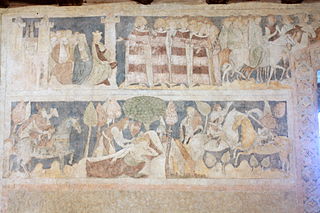
The Lancelot-Grail Cycle, also known as the Vulgate Cycle or the Pseudo-Map Cycle, is an early 13th-century French Arthurian literary cycle consisting of interconnected prose episodes of chivalric romance originally written in Old French. The work of unknown authorship, presenting itself as a chronicle of actual events, retells the legend of King Arthur by focusing on the love affair between Lancelot and Guinevere, the religious quest for the Holy Grail, and the life of Merlin. The highly influential cycle expands on Robert de Boron's "Little Grail Cycle" and the works of Chrétien de Troyes, previously unrelated to each other, by supplementing them with additional details and side stories, as well as lengthy continuations, while tying the entire narrative together into a coherent single tale.
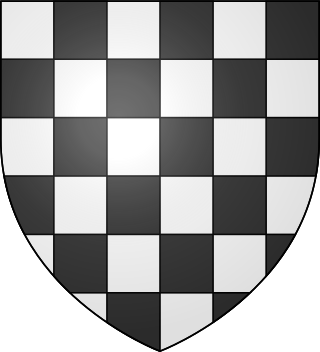
Palamedes is a Knight of the Round Table in the Arthurian legend. He is a Middle Eastern pagan who converts to Christianity later in his life, and his unrequited love for Iseult brings him into frequent conflict with Tristan. Palamedes' father King Esclabor and brothers Safir and Segwarides also join the Round Table. The romance Palamedes was named after him.
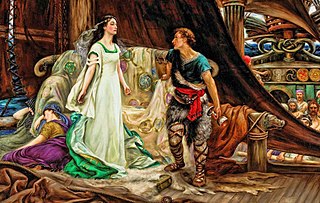
Tristan and Iseult, also known as Tristan and Isolde and other names, is a medieval chivalric romance told in numerous variations since the 12th century. Of disputed source, usually assumed to be primarily Celtic, the tale is a tragedy about the illicit love between the Cornish knight Tristan and the Irish princess Iseult in the days of King Arthur. It depicts Tristan's mission to escort Iseult from Ireland to marry his uncle, King Mark of Cornwall. On the journey, Tristan and Iseult ingest a love potion, instigating a forbidden love affair between them.

The Post-Vulgate Cycle, also known as the Post-Vulgate Arthuriad, the Post-Vulgate Roman du Graal or the Pseudo-Robert de Boron Cycle, is one of the major Old French prose cycles of Arthurian literature from the early 13th century. It is considered essentially a rewriting of the earlier and more popular Vulgate Cycle, with much left out but also much added, including characters and scenes from the Prose Tristan. The cycle has not survived in any manuscript in its entirety and has been reconstructed from French, Spanish, and Portuguese fragments in several medieval languages.
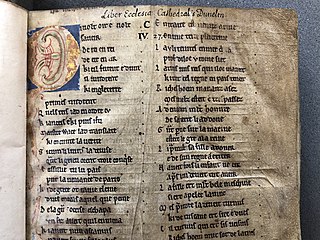
The Brut or Roman de Brut by the poet Wace is a loose and expanded translation in almost 15,000 lines of Norman-French verse of Geoffrey of Monmouth's Latin History of the Kings of Britain. It was formerly known as the Brut d'Engleterre or Roman des Rois d'Angleterre, though Wace's own name for it was the Geste des Bretons, or Deeds of the Britons. Its genre is equivocal, being more than a chronicle but not quite a fully-fledged romance.
Meliodas is a figure in Arthurian legend in the 12th-century Prose Tristan and subsequent accounts. In Thomas Malory's Le Morte d'Arthur, he is the second king of Lyonesse, son of Felec of Cornwall and vassal of King Mark. Meliodas' first wife, Elizabeth, who bore the hero Tristan, was Mark's sister, and his second wife was a daughter or sister of Hoel of Brittany. He is the eponymous protagonist of the romance Meliadus. The Italian variant Tristano Riccardiano calls him Felix (Felissi).
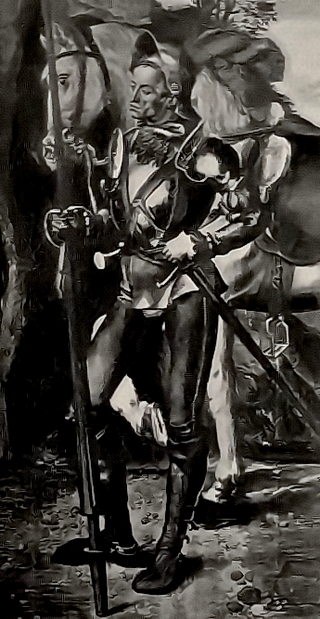
Dinadan is a Cornish Knight of the Round Table in the Arthurian legend's chivalric romance tradition. In the Prose Tristan and its adaptations, Dinadan is a close friend of the protagonist Tristan. Known for his cynical humor and pragmatism, and also for his severe anti-chivalric attitudes in the original French texts, he serves as a foil to Tristan in his softened portrayal in the English compilation Le Morte d'Arthur. In both Malory and his French sources, Dinadan appears in several often comedic episodes until his murder by Mordred and Agravain. Despite his relatively minor role, he has become a major subject of especially Malorian scholarship.
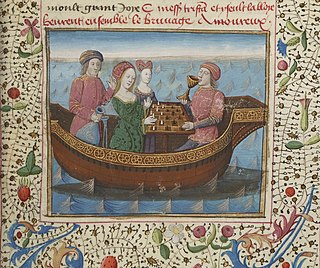
The Prose Tristan is an adaptation of the Tristan and Iseult story into a long prose romance, and the first to tie the subject entirely into the arc of the Arthurian legend. It was also the first major Arthurian prose cycle commenced after the widely popular Lancelot-Grail, which influenced especially the later portions of the Prose Tristan.

Brunor, Breunor, Branor or Brunoro are various forms of a name given to several different characters in the works of the Tristan tradition of Arthurian legend. They include Knight of the Round Table known as Brunor/Breunor le Noir, as well as his father and others, among them another former knight of Uther's old Round Table and the father of Galehaut.
Palamedes is a 13th-century Old French Arthurian prose chivalric romance. Named for King Arthur's knight Palamedes, it is set in the time before the rise of Arthur, and relates the exploits of the parents of various Arthurian heroes. The work was very popular, but now exists largely in fragmentary form.
Cortain is a legendary short sword in the legend of Ogier the Dane. This name is the accusative case declension of Old French corte, meaning "short".